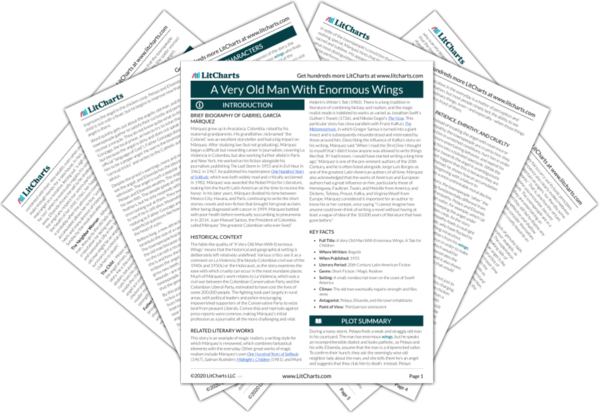During a nasty storm, Pelayo finds a weak and straggly old man in his courtyard. The man has enormous wings, but he speaks an incomprehensible dialect and looks pathetic, so Pelayo and his wife, Elisenda, assume that the man is a shipwrecked sailor. To confirm their hunch, they ask the seemingly wise old neighbor lady about the man, and she tells them he’s an angel and suggests that they club him to death. Instead, Pelayo imprisons the angel in the chicken coop. Pelayo and Elisenda’s child is sick with a fever, but he begins to improve now that the angel is there.
Word quickly gets out about the angelic old man, and the townspeople gather to satisfy their curiosity and perhaps receive a miracle. They do not know quite what to think. Father Gonzaga, the local priest, arrives to try to solve the mystery, but because the angel is dirty and does not speak Latin (the official “language of God”), Father Gonzaga does not believe him to be a proper angel. He warns the townspeople against “carnival tricks” and writes to the Catholic authorities for advice.

Despite the priest’s warnings, more and more people come to see the angel, and Elisenda has the idea to start charging them admission. The angel is such a popular attraction that he makes Pelayo and Elisenda wealthy. The angel, meanwhile, festers in his own filth. The people gawp at him, taunt him, and pull his feathers, but he only responds with supernatural patience, not once lashing out at them. They even brand him with a hot iron to see if he is still alive. Meanwhile, the church authorities replying to Father Gonzaga are more concerned with superficial questions like how many times the angel might fit on the head of a pin.
Before long, a new attraction arrives in town: “a frightful tarantula the size of a ram and with the head of a sad maiden.” The townspeople find the spider woman more relatable than the old man because she speaks the same language as they do, so she can tell a recognizable and moralistic story about who she is and how she became so odd. Her popularity quickly eclipses the angel, whose odd miracles—helping a blind man grow new teeth, or making sunflowers sprout from a leper’s wounds—are simply not miraculous enough for the townspeople. Father Gonzaga is able to let go of the issue now that the general populace is no longer interested.
By this point, Pelayo and Elisenda have amassed enough money to buy a much bigger house. Pelayo quits his job, and Elisenda buys herself some fancy clothes. The child’s health continues to improve, and he sometimes goes into the chicken coop to play near the angel. A doctor comes, but he also cannot explain the angel’s nature.
The child is now strong enough to go to school. The angel goes “dragging” himself about the house like “a stray dying man,” much to the annoyance of Pelayo and Elisenda. His wings are balding and thin.
As time passes, the old man’s condition improves and his feathers return. One day, Elisenda is cooking in the kitchen and notices him trying to fly. Though his attempts are clumsy, eventually he manages to gain altitude and soars over the horizon. Elisenda lets out a sigh of relief, partly for the angel, but mostly for herself—he is “no longer an annoyance in her life.”







